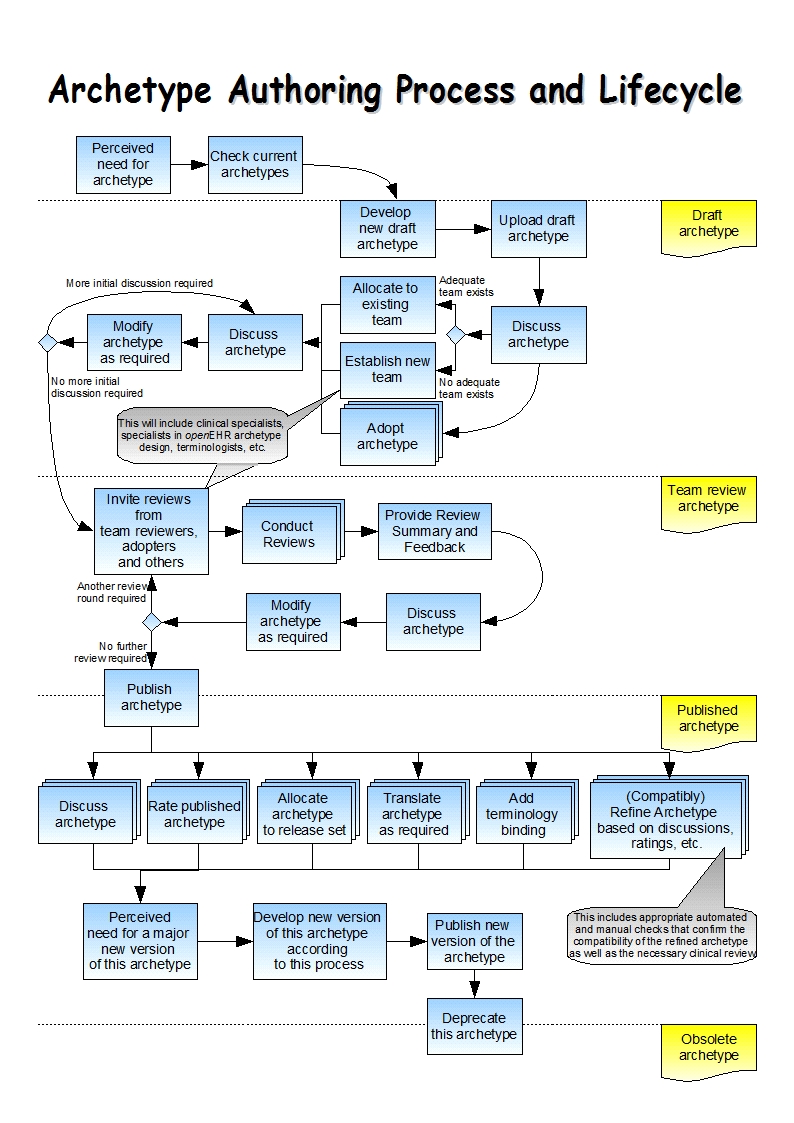Authoring, Review and Publication Overview
The publication of an archetype relies on the agreement on and approval of the clinical content within the archetype through an iterative review process.
The review is conducted by a combination of clinicians and content experts from a broad range of expertise and geographical variation as is possible - this is done in order to represent as many use-cases for a given archetype as possible and ensure that the approved archetype is as close to a sensible maximal data set as can be possible.
Once the content is agreed then the archetype status is set to published. The archetype can be used at this stage, with confidence that the archetype structure and content is relatively stable. Of course, we will never be able to assume an archetype is complete, but the aim to create as stable an archetype as possible at any given point in time.
Once the content is agreed, then two parallel processes are able to commence:
- Adding terminology binding - the work of binding a terminology to an archetype is totally independent of any other terminology binding. So for example, work on binding SNOMED CT to an archetype can occur in parallel to the work on binding ICD to the same archetype; and
- Adding language translations - each language translation can take place independently of others and thus multiple translations can occur in parallel.
In this way, as a language translation is completed or a terminology binding is agreed, this can be added to the published archetype as a revision and made available to others for broader use.
It is acknowledged that some countries or jurisdictions will not allow the archetype to be used until there is approved terminology binding in place. Similarly, others will need translations before they can use it. Some countries and jurisdictions will not have the capability to utilise terminology bindings in the short- to medium-term at all.
The current position of CKM is that bindings and translations should not hold up formal publication of the archetype, but be an enhancement that follows, as soon as they become available.
Addition of terminology bindings and translations will commence once the need is identified and participants identified.
Initial terminology bindings will be developed by binding experts and then submitted for a review process to a broader group. There has been an increasing expression of need for SNOMED CT bindings to be included in archetype development, and we anticipate a strong collaboration between the openEHR CKM and IHTSDO to ensure that SNOMED bindings within archetypes are of high quality. Bindings to other terminologies will require a similar engagement of specific terminology binding experts.
Initial translations will be done by a fluent language speaker with clinical domain knowledge and then submitted for a formal review process to a broader group. Once the bindings and/or translation is agreed in the formal review, then they will be incorporated into the published archetype as a revision.
Archetype Publication States
The individual Archetype Publication States such as Draft, Team review and Published are summarised here.
Authoring, Reviewing and Publication Process
The authoring, reviewing and publication process is summarised in the following diagram:
